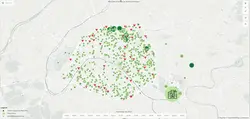PARIS
Building a local, circular food system

About the pilot area
RUE DE MOUZAIA
The 18th Arrondissement of Paris is a mixed-use neighborhood that encompasses both cultural and industrial spaces. The green space share amounts to just 4.6%, which underscores the area's limited access to green environments. With a population density of 32,024 people per square kilometer, the district is filled with activity, yet it faces several distinctive challenges. These include soil and air pollution, soil sealing, gentrification risk, and higher than average unemployment levels. Within a circular city framework, the 18th Arrondissement serves many functions, including acting as a production center, loop closer, innovation - and learning center.

The building at Rue de Mouzaia 58 is an epitome of 20th-century brutalist architecture and holds the "Architecture Contemporaine Remarquable" status, as protected by the City of Paris. The building stands since 1974 but faced abandonment in the 2010s. Today, they house co-working spaces in the basement as well as the offices of Fab City Paris, reflecting a reimagined utilization of these remarkable structures. Owned by the City Council (RIVP), the Mouzaia site offers intriguing possibilities for urban gardening and a revival of past city gardening techniques.
Volumes and Fab City Paris are mapping Paris’ existing skills needed for a circular food production, transformation, distribution, and food waste management. The goal of Paris’ Food System Skills Map is to showcase the contribution of smaller food producers and transformers towards a more sustainable food system. The second goal of our map is to allow citizens to access courses, workshops, and knowledge on alternative food production, transformation, and distribution.
FOLLOW PARIS' CARTOGRAPHY JOURNEY
Paris' urban challenges
-
Waste generation - waste generation
-
Soil pollution - over 600 sites listed as potentially polluted
-
18th Arrondissement challenges
-
Income - Higher than average poverty rates of 21%
-
Unemployment - Higher than average unemployment rates in the 18th and 19th district
-
Soil pollution - Pilot sites (Jardin des traverses deal with polluted soils)
Which insights have been gathered by our local context detectives?
Read through our gallery of local anecdotes, research findings and in-depth analysis
Parallel to Paris’s efforts to understand city and neighbourhood-wide urban challenges, the team has embarked on a journey to create a Food Systems Skills Map by mapping the key actors of Paris’ alternative food system
Who was mapped
Urban farms
Providers of professional agricultural
training
Small businesses transforming food waste into edible food
Alternative food logistics providers (packaging, distribution)
Why?
-
To create a map with existing food system skills in the community
-
To increase visibility of alternative food system actors
-
To identify potential partnerships and collaborations between food system network
How was it useful for the Paris pilot team?
-
Increased awareness of local initiatives
The mapping of makers in Paris was done by a dedicated team member who used an interview guide in informal conversations with makers.
What local resources were mapped?
Knowledge & skills for local food production, distribution and transformation
How was data collected?
-
Online research
-
Stakeholder networking events
Which circular opportunities were identified or explored for further research?
Increasing local food production in regenerative systems
-
Biochar application on brownfields
-
Reuse of excavation materials for soil fertility
-
Carbon storage in abandoned soils
-
Working with training facilities (e.g. Agriculture XYZ) on citizen courses for food waste prevention (teaching preservation and fermentation techniques
Designing foods from waste
-
Developing training courses together with mapped stakeholders in education and food design to reuse food production by-products for new food products
Develop platforms for selling local food products
-
Work on a cooperative network of food producers and sellers, selling locally processed foods - to date, this only exists for fresh produce but not for transformed and processed products
Increase food waste composting
-
Work with local composting initiative to scale composting efforts, e.g. by creating a network of schools that start to donate their compost






